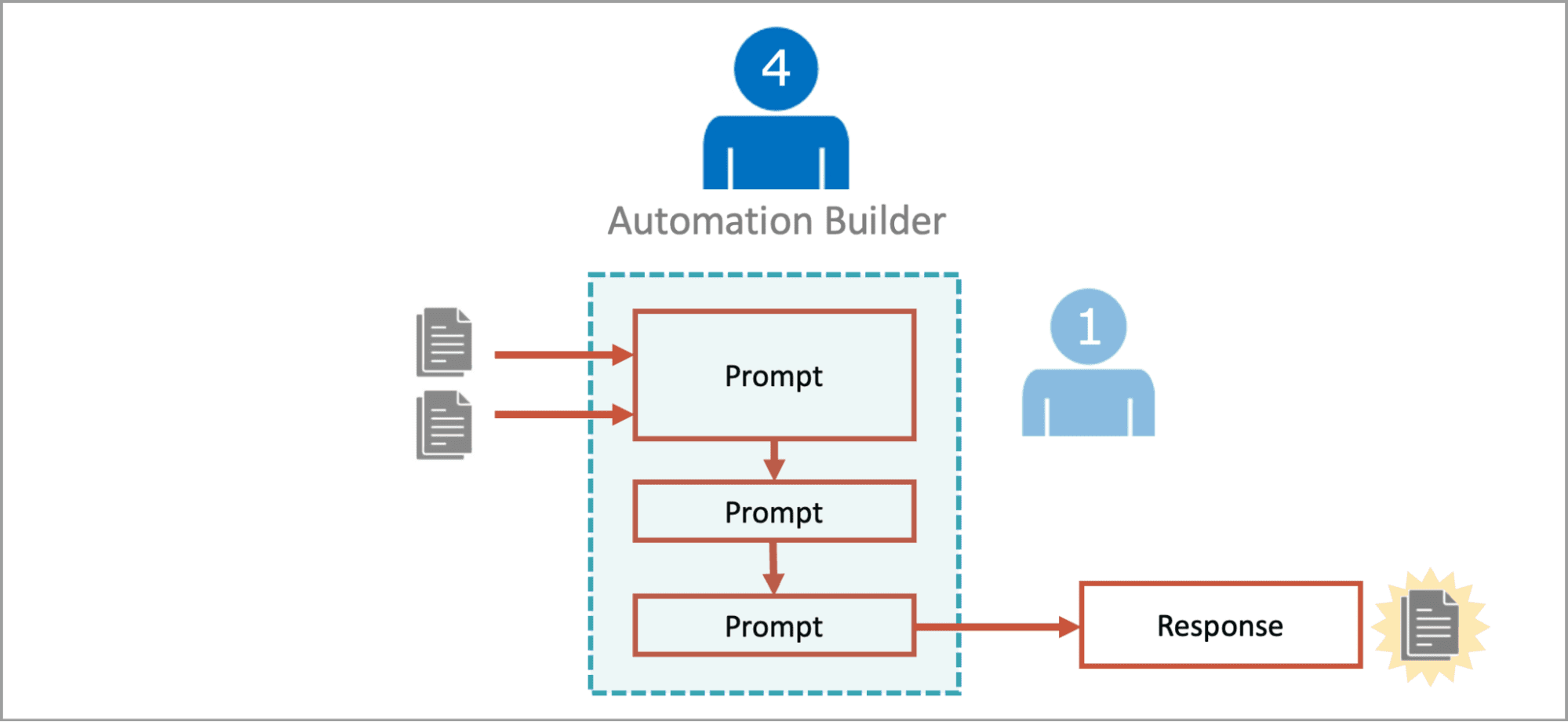Gamma aims to free you from ‘death by PowerPoint’—with help from AI
If there’s one thing worse than having to assemble a PowerPoint presentation, it’s being forced to sit through an achingly dull one conducted by someone else. So what if there were a better option—a way anyone, regardless of skill, could create a sleek and actually engaging slideshow that looks like a professional designer had a hand in it? If you ask Grant Lee, we’ve already reached the point where that’s possible. And it doesn’t end with presentations. Lee is the founder of an AI-centric startup called Gamma. You may not have heard of it yet, but 50 million people have—and are already using the service. That’s led the scrappy, 30-person company to reach a milestone of $50 million in annual recurring revenue a mere two years into its existence. “I realized just how important it was for people to be able to communicate their ideas in a visual way that others can consume,” Lee says. “Many of us have these ideas in our heads, but then to be able to actually convey that in a way that gets in other people’s heads—it’s really hard.” Lee came to that realization while working in investment banking. He spent his days immersed in underwhelming, clunky-to-create slide decks. Now, he wants to make sure no one else is forced to dawdle their days away with those sorts of distractions. If you’ve wasted any amount of time wading through painfully bad presentations—or documents, websites, or social media posts—Gamma could be just the upgrade you never knew you needed. But, like most generative AI tools of the moment, it isn’t without its limitations. A broader approach to AI creation Let’s get one thing out of the way now: On the surface, Gamma seems an awful lot like another AI-centric startup I wrote about for Fast Company last year—a now-eight-year-old presentation-making service called Beautiful.ai. But while both services do aim to take the pain out of presentation creation, they differ not only in their philosophical foundations but also in the scope of what they offer. “All of these [other] tools actually have the same sort of approach, which is a design-first approach,” Lee says. “We’ve always taken a completely different approach, which is: What if we were design later, or even design last? What if we were content first?” To that end, Gamma encourages you to not even think about things from a visual perspective. Instead, you just focus on the message, and the tool transforms that into any medium and form you want. “You start with writing or an outline or existing notes, then we turn that into something that’s much more dynamic, with rich content that can be shareable,” Lee says. Specifically, when you launch a new project in Gamma, you’re presented with three choices. You can paste in text—be it a series of loose notes or a fully finished document; you can import an existing document, presentation, or slideshow from PowerPoint, Google Slides, or another similar program; or you can simply input a single-line prompt and have Gamma’s network of AI models take the reins from there. Gamma gives you three choices to start creating, all with AI at the core. “We don’t expect you to go in and try to move pixels around,” Lee explains. “We expect you to go in with your thoughts. We’re going to help you shape them [and] visualize them.” So, yes: You can drag and drop elements and adjust specific parameters around colors, styling, and so on. But the idea is that you don’t have to do that. Instead, you can let Gamma handle that heavy lifting while you focus entirely on what you want to say—not how you want to convey it. “We’re not trying to be incrementally better slide-ware,” Lee says. “We’re introducing a new set of building blocks.” Lee’s ultimate goal is to allow us, as humans, to focus solely on the content itself by leaning on AI to handle practically everything else. Even if Gamma’s creations are more of a starting point than a final, polished product, working with the framework it gives you is intended to be akin to editing a document—with a handy virtual helper at your side every step of the way. Want to improve the writing, for instance? Tighten up your copy? Even just make some block of text more visually appealing—or replace some existing images with more eye-catching illustrations? You’ll find one-step commands for all of those things within Gamma’s slide-by-slide AI menus. All you’ve gotta do is click. Gamma has all sorts of AI-powered tools for editing, refining, and improving your creations. “It’s as if you have your expert designer sitting right next to you,” Lee says. “At the end, you get a beautiful output, and regardless of your technical or design abilities, you feel like you have something you’re proud to present to others.” The million-dollar question, of course, is how well all of that actually works in practice. After all, nearly every AI tool sounds incredible on paper. But when you move beyond the carefully controlled demos an
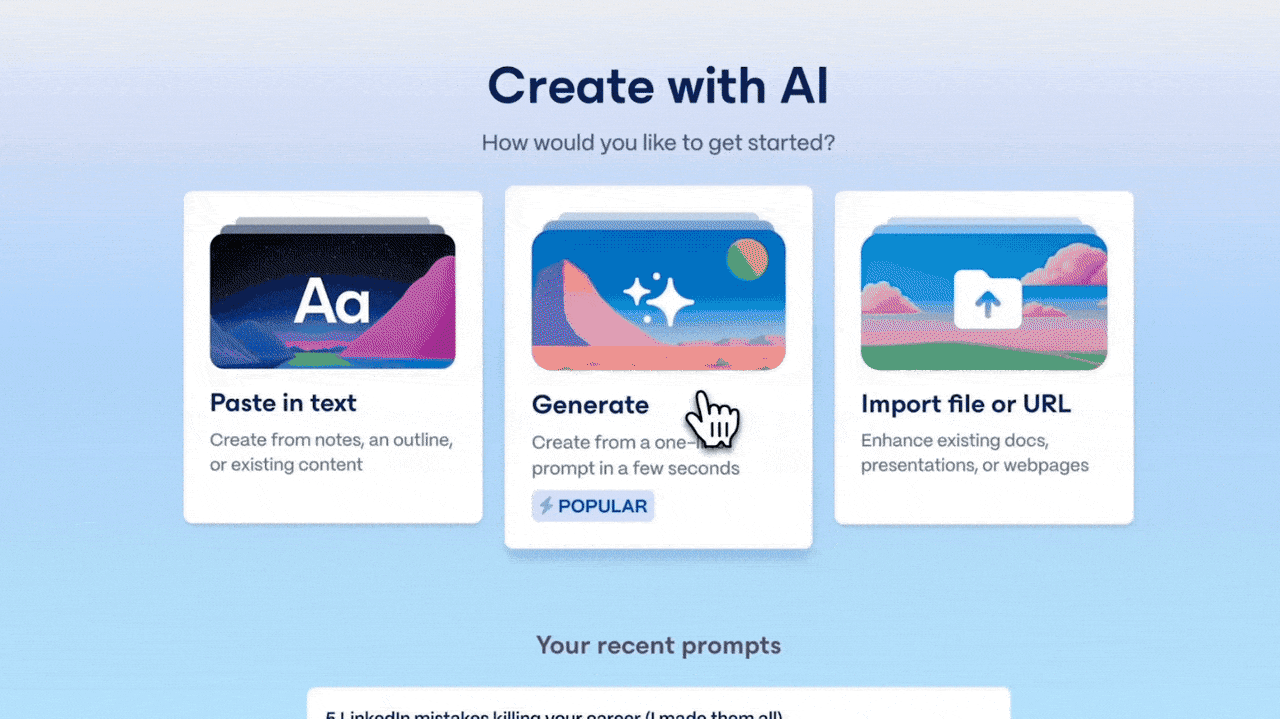
If there’s one thing worse than having to assemble a PowerPoint presentation, it’s being forced to sit through an achingly dull one conducted by someone else.
So what if there were a better option—a way anyone, regardless of skill, could create a sleek and actually engaging slideshow that looks like a professional designer had a hand in it?
If you ask Grant Lee, we’ve already reached the point where that’s possible. And it doesn’t end with presentations.
Lee is the founder of an AI-centric startup called Gamma. You may not have heard of it yet, but 50 million people have—and are already using the service. That’s led the scrappy, 30-person company to reach a milestone of $50 million in annual recurring revenue a mere two years into its existence.
“I realized just how important it was for people to be able to communicate their ideas in a visual way that others can consume,” Lee says. “Many of us have these ideas in our heads, but then to be able to actually convey that in a way that gets in other people’s heads—it’s really hard.”
Lee came to that realization while working in investment banking. He spent his days immersed in underwhelming, clunky-to-create slide decks. Now, he wants to make sure no one else is forced to dawdle their days away with those sorts of distractions.
If you’ve wasted any amount of time wading through painfully bad presentations—or documents, websites, or social media posts—Gamma could be just the upgrade you never knew you needed.
But, like most generative AI tools of the moment, it isn’t without its limitations.
A broader approach to AI creation
Let’s get one thing out of the way now: On the surface, Gamma seems an awful lot like another AI-centric startup I wrote about for Fast Company last year—a now-eight-year-old presentation-making service called Beautiful.ai.
But while both services do aim to take the pain out of presentation creation, they differ not only in their philosophical foundations but also in the scope of what they offer.
“All of these [other] tools actually have the same sort of approach, which is a design-first approach,” Lee says. “We’ve always taken a completely different approach, which is: What if we were design later, or even design last? What if we were content first?”
To that end, Gamma encourages you to not even think about things from a visual perspective. Instead, you just focus on the message, and the tool transforms that into any medium and form you want.
“You start with writing or an outline or existing notes, then we turn that into something that’s much more dynamic, with rich content that can be shareable,” Lee says.
Specifically, when you launch a new project in Gamma, you’re presented with three choices. You can paste in text—be it a series of loose notes or a fully finished document; you can import an existing document, presentation, or slideshow from PowerPoint, Google Slides, or another similar program; or you can simply input a single-line prompt and have Gamma’s network of AI models take the reins from there.
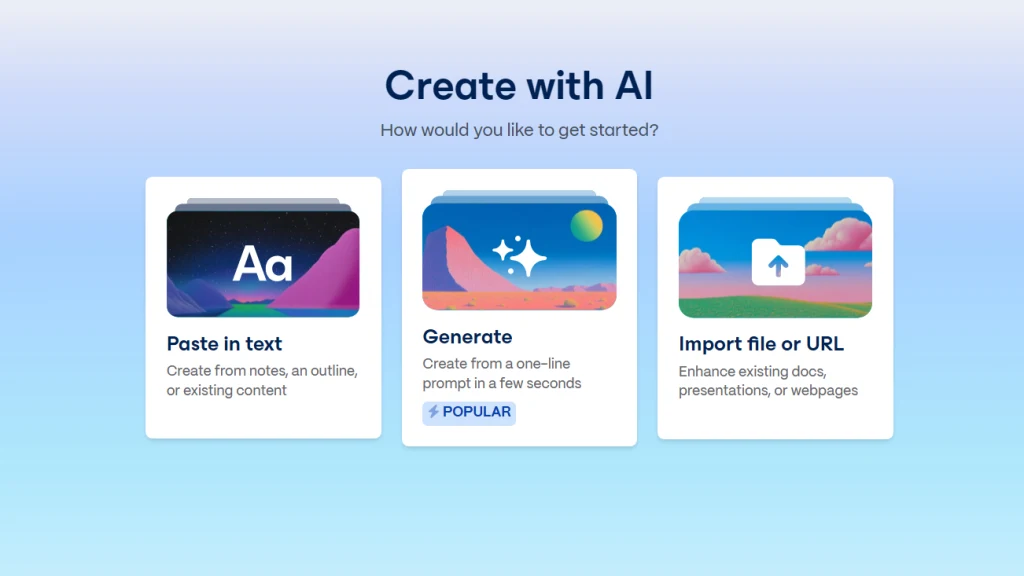
“We don’t expect you to go in and try to move pixels around,” Lee explains. “We expect you to go in with your thoughts. We’re going to help you shape them [and] visualize them.”
So, yes: You can drag and drop elements and adjust specific parameters around colors, styling, and so on. But the idea is that you don’t have to do that. Instead, you can let Gamma handle that heavy lifting while you focus entirely on what you want to say—not how you want to convey it.
“We’re not trying to be incrementally better slide-ware,” Lee says. “We’re introducing a new set of building blocks.”
Lee’s ultimate goal is to allow us, as humans, to focus solely on the content itself by leaning on AI to handle practically everything else. Even if Gamma’s creations are more of a starting point than a final, polished product, working with the framework it gives you is intended to be akin to editing a document—with a handy virtual helper at your side every step of the way.
Want to improve the writing, for instance? Tighten up your copy? Even just make some block of text more visually appealing—or replace some existing images with more eye-catching illustrations? You’ll find one-step commands for all of those things within Gamma’s slide-by-slide AI menus. All you’ve gotta do is click.
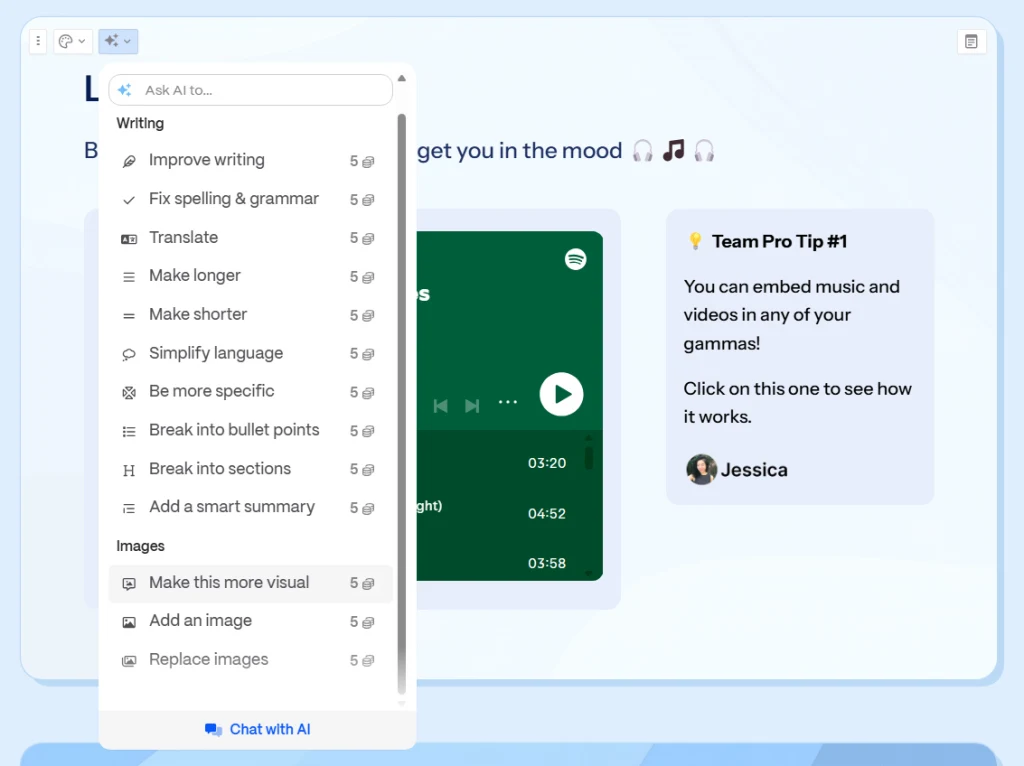
“It’s as if you have your expert designer sitting right next to you,” Lee says. “At the end, you get a beautiful output, and regardless of your technical or design abilities, you feel like you have something you’re proud to present to others.”
The million-dollar question, of course, is how well all of that actually works in practice. After all, nearly every AI tool sounds incredible on paper. But when you move beyond the carefully controlled demos and start actually trying to use this type of technology in the wild, it’s frequently far less impressive than it initially appears.
The short answer with Gamma is that it depends—both on the type of input you’re providing and on your expectations for how, exactly, the service should operate.
The ups and downs of the AI designer
We’ll start with the not-so-good piece of the puzzle: When I’ve tried putting in already-created PDFs or presentations and asking Gamma to jazz them up for me, the results haven’t exactly been awe-inspiring.
Here, for instance, is a peek at Gamma’s take on an existing media kit presentation I had for my independent newsletter-publishing business, The Intelligence:
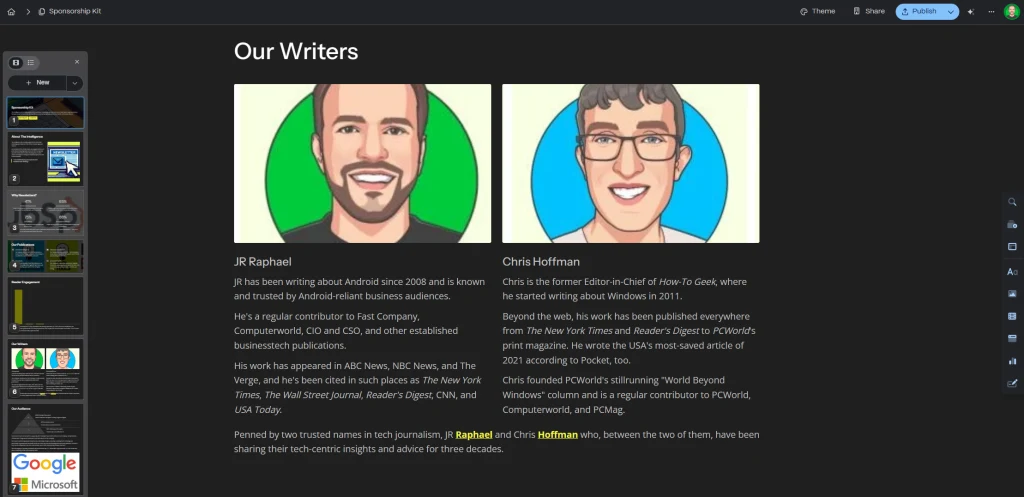
It’s an awkward and ineffective interpretation of the original that honestly feels like a step in the wrong direction.
Where Gamma has worked better, for me, has been when I start fresh. I give it a simple prompt, let it build a completely new framework on its own, and then use that as a starting point to fill in the actual info I want and finish things off from there.
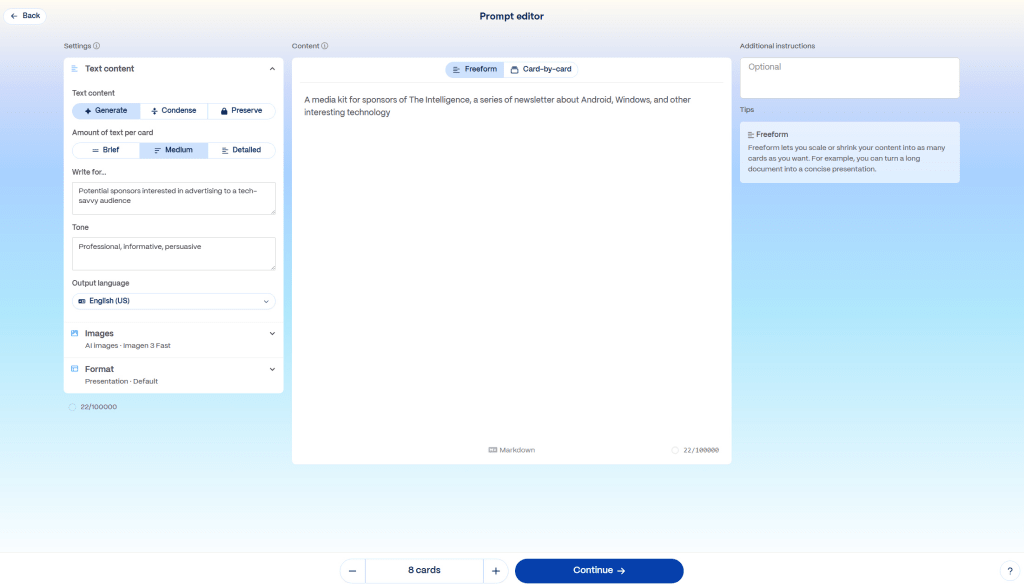
With that in mind, I tried to re-create that very same media kit from scratch, and the results were actually pretty decent. The specific information here isn’t at all accurate or even remotely related to reality, but it creates an interesting and attractive structure to use for adding in the right data and molding it into something sensible.
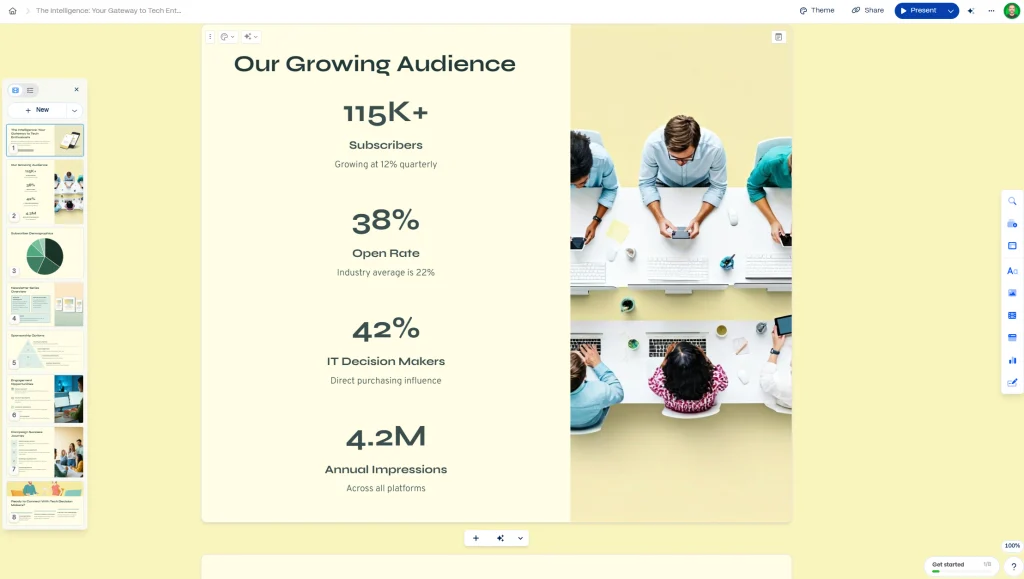
And even that part of the process can be pleasingly easy—with Gamma offering a helping hand, as needed, to refine and polish everything from text to the layout itself as individual assets move around.
All that AI effort does come at a cost, as you’d imagine. Gamma leans on a variety of generative AI engines to power its product—everything from OpenAI to Anthropic and Google’s Gemini technology, though the underlying logic automatically selects what it believes to be the best option for any given purpose, and you’re rarely aware of which model is being used when. Because of the expenses involved, Gamma’s free tier limits you to 400 AI credits per account and only basic AI image generation. For the full experience, you’ll need to pony up $96 a year for unlimited AI creation and advanced image access—or bump up to $180 a year for even more powerful capabilities.
Long term, Lee believes Gamma will be able to provide enough value in exchange that the tradeoff will be a no-brainer.
The Gamma vision
So far, Lee says Gamma’s customers have primarily been a category of users he calls “prosumers”—individuals or small teams that need to create a lot of visuals and wouldn’t typically have the resources to work with a full-fledged design team in their organizations.
But he envisions a future in which everyone, from freelancers and small business owners to sales and marketing teams in larger companies, relies on Gamma to do what’d otherwise require a lot of time, effort, and aggravation—even when traditional resources are readily available.
And you’d better believe that same principle applies to creating PDFs, websites, and social media assets as much as it does presentations (and Lee says the list of available formats will only expand from here). The humble, hated slide deck was just the easiest and most logical entry point to what Lee sees as an entire ecosystem of convenient content creation—all with AI at its core.

“We chose slides as the sort of initial wedge because slides as a format is ubiquitous,” he says. “[But] knowledge workers don’t just need to create slides. They actually have a need to create all forms of content.”
Lee sees it all as a sliding scale with lots of blurred lines. At the end of the day, what’s really the difference between a presentation and a PDF? Or a PDF and a website? Or a website and a promotional LinkedIn post? Once you start relying on Gamma to help you create anything and everything, you quickly realize the various formats all share the same basic building blocks. And it doesn’t take much to move from one to the next.
“Our bet is that presentations can always just be the gateway,” he explains. “We don’t want our users to have to think about it in a traditional sense—like, ‘Oh, I’m creating a slide deck.’ It’s more, ‘I’m creating a piece of content, and that can be consumed in different ways.’”
The challenge, then, is getting people—and organizations—to break their habits and inch away from the uninspiring but familiar tools they’ve relied on for ages. And by making Gamma so simple to use that it requires virtually no specific skills or training, Lee’s optimistic he can win over crowds and frame the service as the one-stop shop for anything creative.
“A tool like Gamma is trying to lower the floor so any knowledge worker can pick up skills that they couldn’t have imagined being able to do in the past,” he says. “We really believe that’ll open up doors for them.”
Be the first to find all sorts of interesting tech tools with my free Cool Tools newsletter from The Intelligence. You’ll get a single new off-the-beaten-path discovery in your inbox every Wednesday!































































































































